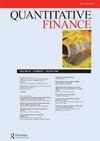Quantum-inspired variational algorithms for partial differential equations: application to financial derivative pricing
IF 1.4
4区 经济学
Q3 BUSINESS, FINANCE
引用次数: 0
Abstract
AbstractVariational quantum Monte Carlo (VMC) combined with neural-network quantum states offers a novel angle of attack on the curse-of-dimensionality encountered in a particular class of partial differential equations (PDEs); namely, the real- and imaginary time-dependent Schrödinger equation. In this paper, we present a simple generalization of VMC applicable to arbitrary time-dependent PDEs, showcasing the technique in the multi-asset Black-Scholes PDE for pricing European options contingent on many correlated underlying assets.Keywords: Variational quantum algorithmsVariational quantum Monte CarloMulti-asset Black-Scholes PDE AcknowledgmentsThe Authors thank the anonymous AE and the referees for their suggestions, which helped to improve our paper.Disclosure statementNo potential conflict of interest was reported by the author(s).Notes1 VQAs for mult-asset financial derivative pricing have been subsequently explored in Kubo et al. (Citation2022).2 See appendix 1 for a derivation. Similiar ODEs have been introduced in the neural Galerkin method (Bruna et al. Citation2022).3 This can be considered as a special case of the complex-valued case (Hibat-Allah et al. Citation2020, Sharir et al. Citation2020).Additional informationFundingAuthors gratefully acknowledge support from NSF under grants DMS-2038030 and DMS-2006305. This research was supported in part through computational resources and services provided by the Advanced Research Computing (ARC) at the University of Michigan.偏微分方程的量子启发变分算法:在金融衍生品定价中的应用
摘要变分量子蒙特卡罗(VMC)与神经网络量子态相结合,为解决一类特定偏微分方程(PDEs)的维数问题提供了一种新的攻角;即与时间相关的实数和虚数Schrödinger方程。在本文中,我们给出了适用于任意时变偏微分方程的VMC的简单推广,展示了基于许多相关标的资产的多资产Black-Scholes偏微分方程的欧洲期权定价技术。关键词:变分量子算法变分量子蒙特卡罗多资产Black-Scholes PDE致谢感谢匿名AE和审稿人的建议,他们帮助我们改进了论文。披露声明作者未报告潜在的利益冲突。注1 Kubo等人随后对多资产金融衍生品定价的vqa进行了探讨(Citation2022)参见附录1的推导。神经伽辽金方法(Bruna et al.)也引入了类似的ode。Citation2022)。3这可以看作是复值情况(Hibat-Allah et al.)的一个特例。引文2020,Sharir et al.。Citation2020)。作者感谢NSF在DMS-2038030和DMS-2006305项目下的支持。这项研究在一定程度上得到了密歇根大学高级研究计算(ARC)提供的计算资源和服务的支持。
本文章由计算机程序翻译,如有差异,请以英文原文为准。
求助全文
约1分钟内获得全文
求助全文
来源期刊

Quantitative Finance
社会科学-数学跨学科应用
CiteScore
3.20
自引率
7.70%
发文量
102
审稿时长
4-8 weeks
期刊介绍:
The frontiers of finance are shifting rapidly, driven in part by the increasing use of quantitative methods in the field. Quantitative Finance welcomes original research articles that reflect the dynamism of this area. The journal provides an interdisciplinary forum for presenting both theoretical and empirical approaches and offers rapid publication of original new work with high standards of quality. The readership is broad, embracing researchers and practitioners across a range of specialisms and within a variety of organizations. All articles should aim to be of interest to this broad readership.
 求助内容:
求助内容: 应助结果提醒方式:
应助结果提醒方式:


